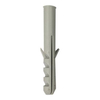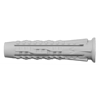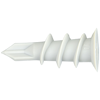Wall Plugs
Wall Plugs
Are you looking for high-quality wall plugs? Wovar offers a wide range of plugs that are suitable for almost any application. You can easily hang a mirror on a stone wall with our nylon plugs. Do you want to mount something to a plaster wall? Then choose our plasterboard fixings.
Wovar supplies a suitable plug for every application. We offer hollow wall plugs, universal plugs, hammer plugs, plasterboard plugs, nylon plugs, and frame fixings. Below you can read about our different types of wall plugs and when to pick which plug. In addition to selecting the right plugs, it is also important that you combine the right screws with the chosen plug.
Which wall plug do I need?
In order to arrive at the right answer, the first step is to find out whether you are dealing with a hollow wall or a solid wall/ceiling. A plasterboard wall would be an example of a hollow wall. A solid wall is one made of stone, concrete, or plaster blocks. For hollow walls, use hollow wall plugs. And with solid walls, you can use hammer plugs or nylon plugs.
Do you want to always have a suitable wall plug on hand? Then order our universal plugs. These are suitable for both solid walls and hollow walls. This is because the fixing contorts into a knot when the screw is tightened.
Nylon plugs
In the list below, you can read which screw size belongs to which plug size for our nylon plugs, the maximum load it can support, and the required diameter and depth of the pilot hole.
- Plug size: 4 x 20 mm. Drill a hole to a depth of 25 mm with a 4 mm thick drill bit. Use a 3 mm thick screw. You can attach a maximum weight of 10 kg.
- Plug size: 5 x 25 mm. Drill a hole to a depth of 30 mm with a 5 mm thick drill bit. Use a 2.5 - 4 mm thick screw. You can attach a maximum weight of 25 kg.
- Plug size: 6 x 30 mm. Drill a hole to a depth of 35 mm with a 6 mm thick drill bit. Use a 3.5 - 5 mm thick screw. You can attach a maximum weight of 60 kg.
- Plug size: 8 x 40 mm. Drill a hole to a depth of 45 mm with a 8 mm thick drill bit. Use a 4.5 - 6 mm thick screw. You can attach a maximum weight of 60 kg.
- Plug size: 10 x 50 mm. Drill a hole to a depth of 55 mm with a 10 mm thick drill bit. Use a 6 - 8 mm thick screw. You can attach a maximum weight of 100 kg.
- Plug size: 12 x 60 mm. Drill a hole to a depth of 65 mm with a 12 mm thick drill bit. Use a 8 - 10 mm thick screw. You can attach a maximum weight of 150 kg.
Universal plugs
The universal plug, as the name suggests, is suitable for all kinds of surfaces. This means the plug can be used for both solid walls, like concrete and stone, and for hollow walls, like plaster walls or hollow brick walls. This is because the fixing contorts into a knot when the screw is tightened.
Hollow wall fixings
With a hollow wall, you can use our hollow wall plugs, also called cavity wall fixings or hollow wall anchors. You can recognise a hollow wall plug by its unique shape. You fold the rear part to push the plug through the hole, after which it will expand when the screw is tightened.
First, drill a hole in the hollow wall with a drill bit that is 2 mm thicker than the thickness of the plug. For example, hollow wall fixings 8 x 40 mm require a 10 mm thick drill bit. Press the flaps of the hollow wall plug together and push it through the hole. Next, tighten the screw in the plug. The screw ensures that the plug is clamped in place. If you opt for hollow wall plugs without screws, you will have to order the screws separately. For 8 mm hollow wall fixings, choose 3.5 mm thick full-thread screws.
Hammer and frame fixings
You need hammer fixings or frame fixings when you want to fix a wooden beam or sheet material to a stone or concrete wall. The advantage of these plugs is that you hold the material in the desired location on the wall and drill a hole in one go. Then push the hammer or frame fixing into the hole and drive it in with a hammer. In this way, you can quickly anchor materials to a stone wall. The material is now firmly attached to the wall or ceiling. Frame fixings have the same effect as hammer fixings, but they are longer and thicker, resulting in a higher load-bearing capacity.
Plasterboard fixings
These plasterboard fixings are suitable exclusively for plasterboard walls. Thanks to the self-drilling tip, drilling a pilot hole is not necessary. For the best end result, however, drilling a small pilot hole is recommended. This ensures that the collar of the screw is flush with the plasterboard. If you do not want to drill a pilot hole, you should screw in the plasterboard fixing until the head is flush with the plasterboard.
A big difference compared to other plugs is that the shape of these plasterboard plugs does not change when the screw is tightened. Where other wall plugs expand, contract or change into a knot, plasterboard fixings retain their shape. A disadvantage of these plasterboard plugs is that they leave a large hole if you remove the wall plug. A big advantage is that these fixings are very strong and have a high load-bearing capacity.
Businesses in the landscaping and construction industry receive extra benefits such as a discount with a business account.






